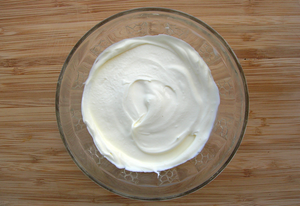Cookbook:Crème Fraiche
| Crème Fraiche | |
|---|---|
 | |
| Category | Dairy |
Cookbook | Recipes | Ingredients | Equipment | Techniques | Cookbook Disambiguation Pages | Ingredients

Crème fraîche is a cultured cream product similar but not identical to sour cream.[1]
Characteristics
[edit | edit source]Crème fraîche is made either by allowing raw cream to culture naturally or by introducing lactic acid cultures to pasteurized cream.[2][3] This process results in a slight acidification, which thickens the cream and gives it a tangy flavor.[4][3][5] In general, the cream used has at least 30% fat, which makes the product smooth and rich.[4][6] The exact texture varies slightly, and it can be thin to thick,[2] depending on the culture time and amount of moisture left in the final product.
Selection and storage
[edit | edit source]Crème fraîche is perishable and must be kept in the fridge to prevent it from over souring and eventually spoiling.[6] Discard if you see any mold or pink patches growing on it.
Use
[edit | edit source]Crème fraîche is particularly useful in finishing sauces in French cooking because its high fat content reduces its risk curdling when heated.[1][5][7] However, "light" crème fraîche with a low fat content will curdle when heated. Crème fraîche is also used as a topping for fruits and desserts, and it can be incorporated into ganache and other confections.[6]
Substitution
[edit | edit source]If you can't get your hands on crème fraîche, you can make it yourself by mixing cultured buttermilk into heavy cream (about 5–20% buttermilk by volume) and letting it sit at room temperature (~70°F/22°C) for 12–36 hours until soured and thickened to your preference.[1][2][6][7] Sour cream also makes a reasonable substitute, though you should note that the fat and moisture contents can differ between sour cream and crème fraîche.
Recipes
[edit | edit source]References
[edit | edit source]- ↑ a b c Gisslen, Wayne (2016-09-21). Professional Baking. John Wiley & Sons. ISBN 978-1-119-14844-9.
- ↑ a b c Amendola, Joseph; Rees, Nicole (2003-01-03). Understanding Baking: The Art and Science of Baking. Wiley. ISBN 978-0-471-44418-3.
- ↑ a b The Chefs of Le Cordon Bleu (2011-12-02). Le Cordon Bleu Patisserie and Baking Foundations. Cengage Learning. ISBN 978-1-4390-5713-1.
- ↑ a b The Culinary Institute of America (CIA) (2015-02-25). Baking and Pastry: Mastering the Art and Craft. John Wiley & Sons. ISBN 978-0-470-92865-3.
- ↑ a b Labensky, Sarah R.; Hause, Alan M.; Martel, Priscilla (2018-01-18). On Cooking: A Textbook of Culinary Fundamentals. Pearson. ISBN 978-0-13-444190-0.
- ↑ a b c d Rinsky, Glenn; Rinsky, Laura Halpin (2008-02-28). The Pastry Chef's Companion: A Comprehensive Resource Guide for the Baking and Pastry Professional. John Wiley & Sons. ISBN 978-0-470-00955-0.
- ↑ a b Ruhlman, Michael (2008). The Elements of Cooking: Translating the Chef's Craft for Every Kitchen. Black Incorporated. ISBN 978-1-86395-143-2.
